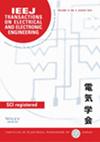求助PDF
{"title":"Loss Minimization Model Predictive Current Control for Linear Induction Motors","authors":"Shuhang Ma, Jinghong Zhao, Lv Yang, Yuanzheng Ma, Hanming Wang","doi":"10.1002/tee.24113","DOIUrl":null,"url":null,"abstract":"<p>To further improve the operating efficiency of linear induction motor, this paper proposes a loss minimization model predictive current control method based on governable loss online calculation. First, the method derives the equivalent circuit of linear induction motor containing independent iron loss branches, and establishes the loss model containing iron loss. Second, the expressions of stator d-axis current with governable losses and secondary flux amplitude are derived from theoretical analysis, and then a given value of stator d-axis current is derived when the governable losses are minimal. Then, a chain observer is designed to observe the secondary flux and calculate the governable loss and stator d-axis current under the current operation. Finally, a method is proposed to introduce the stator d-axis current observation results into the model predictive current control, which ensures the loss suppression effect and improves the dynamic performance at the same time. In addition, this article also compares the loss minimization controllers with or without iron loss. The simulation results are consistent with the theory, and the optimal control of the secondary flux of the linear induction motor can be successfully realized, thus effectively reducing the energy loss of the motor in the dynamic operation process. © 2024 Institute of Electrical Engineers of Japan and Wiley Periodicals LLC.</p>","PeriodicalId":13435,"journal":{"name":"IEEJ Transactions on Electrical and Electronic Engineering","volume":"19 9","pages":"1542-1552"},"PeriodicalIF":1.0000,"publicationDate":"2024-07-23","publicationTypes":"Journal Article","fieldsOfStudy":null,"isOpenAccess":false,"openAccessPdf":"","citationCount":"0","resultStr":null,"platform":"Semanticscholar","paperid":null,"PeriodicalName":"IEEJ Transactions on Electrical and Electronic Engineering","FirstCategoryId":"5","ListUrlMain":"https://onlinelibrary.wiley.com/doi/10.1002/tee.24113","RegionNum":4,"RegionCategory":"工程技术","ArticlePicture":[],"TitleCN":null,"AbstractTextCN":null,"PMCID":null,"EPubDate":"","PubModel":"","JCR":"Q4","JCRName":"ENGINEERING, ELECTRICAL & ELECTRONIC","Score":null,"Total":0}
引用次数: 0
引用
批量引用
Abstract
To further improve the operating efficiency of linear induction motor, this paper proposes a loss minimization model predictive current control method based on governable loss online calculation. First, the method derives the equivalent circuit of linear induction motor containing independent iron loss branches, and establishes the loss model containing iron loss. Second, the expressions of stator d-axis current with governable losses and secondary flux amplitude are derived from theoretical analysis, and then a given value of stator d-axis current is derived when the governable losses are minimal. Then, a chain observer is designed to observe the secondary flux and calculate the governable loss and stator d-axis current under the current operation. Finally, a method is proposed to introduce the stator d-axis current observation results into the model predictive current control, which ensures the loss suppression effect and improves the dynamic performance at the same time. In addition, this article also compares the loss minimization controllers with or without iron loss. The simulation results are consistent with the theory, and the optimal control of the secondary flux of the linear induction motor can be successfully realized, thus effectively reducing the energy loss of the motor in the dynamic operation process. © 2024 Institute of Electrical Engineers of Japan and Wiley Periodicals LLC.
线性感应电机的损耗最小化模型预测电流控制
为进一步提高直线感应电机的运行效率,本文提出了一种基于可控损耗在线计算的损耗最小化模型预测电流控制方法。首先,该方法推导出了包含独立铁损支路的直线感应电机等效电路,并建立了包含铁损的损耗模型。其次,通过理论分析得出定子 d 轴电流与可控损耗和次级磁通幅值的表达式,然后得出可控损耗最小时定子 d 轴电流的给定值。然后,设计了一个链式观测器来观测二次磁通,并计算当前运行下的可控损耗和定子 d 轴电流。最后,提出了一种将定子 d 轴电流观测结果引入模型预测电流控制的方法,从而在确保损耗抑制效果的同时提高了动态性能。此外,本文还比较了有铁损和无铁损的损耗最小化控制器。仿真结果与理论相符,成功实现了对直线感应电机次级磁通的优化控制,从而有效降低了电机在动态运行过程中的能量损耗。© 2024 日本电气工程师学会和 Wiley Periodicals LLC。
本文章由计算机程序翻译,如有差异,请以英文原文为准。

 求助内容:
求助内容: 应助结果提醒方式:
应助结果提醒方式:


